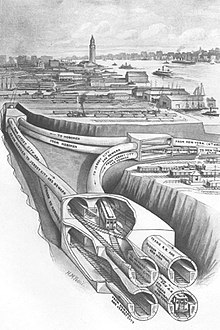KML is from Wikidata
 1909 illustration of flying junction of Uptown Hudson Tubes in Jersey City, New Jersey, which connect to Downtown tubes to the south | |
| Overview | |
|---|---|
| Location | Hudson River |
| Coordinates | 40°42′54″N 74°01′28″W / 40.7151°N 74.0244°W |
| System | PATH |
| Start | World Trade Center |
| End | Exchange Place |
| Operation | |
| Constructed | 1905–1909 |
| Opened | July 19, 1909 |
| Traffic | Railroad |
| Character | Rapid transit |
| Technical | |
| Design engineer | Charles M. Jacobs |
| Length | 5,700 ft (1,737 m)[1] |
| Track gauge | 4 ft 8+1⁄2 in (1,435 mm) standard gauge |
| Electrified | Third rail, 600 V DC |
| Tunnel clearance | 15.25 ft (4.65 m)[1] |
| Depth of tunnel below water level | 97 ft (29.6 m) below sea level[1] |
The Downtown Hudson Tubes (formerly the Cortlandt Street Tunnel[2]) are a pair of tunnels that carry PATH trains under the Hudson River in the United States, between New York City to the east and Jersey City, New Jersey, to the west. The tunnels run between the World Trade Center station on the New York side and the Exchange Place station on the New Jersey side.
PATH operates two services through the Downtown Tubes, Newark–World Trade Center and Hoboken–World Trade Center. The former normally operates 24/7, while the latter only operates on weekdays.[3]
- ^ a b c Cite error: The named reference
Fitzherbertwas invoked but never defined (see the help page). - ^ "BUYING BY SPECULATORS NEAR TUNNEL TERMINAL; Frequent Purchases on Dey, Fulton, and Vesey Streets -- Territory West of Broadway Commanding More Attention -- Ownership Covering a Century Ended Last Week". The New York Times. February 26, 1905. ISSN 0362-4331. Archived from the original on May 2, 2018. Retrieved May 2, 2018.
- ^ "PATH Timetable". Port Authority of New York and New Jersey. January 2019. Archived from the original on June 29, 2021. Retrieved January 14, 2019.
